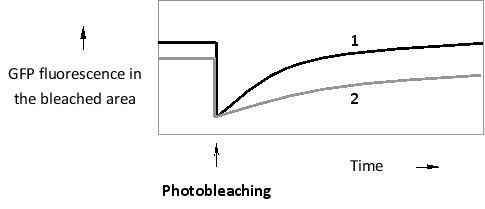Short Answer
A certain GTP-binding protein can exist in two main states. When bound to GDP, it is mostly cytosolic. In its GTP-bound form, however, it associates with the cytosolic face of the endoplasmic reticulum (ER) membrane, where it hydrolyzes the bound GTP after a short delay and is released again into the cytosol. You have created and expressed green fluorescent protein (GFP) fusions of the wild-type protein, as well as that of a mutant protein that does not bind GTP as readily as the wild type. You then perform a fluorescence recovery after photobleaching (FRAP) experiment by photobleaching a small area of the ER membrane and measuring GFP fluorescence recovery over time. According to the results below, which curve (1 or 2) do you think corresponds to the wild-type fusion protein? Write down 1 or 2 as your answer.

Correct Answer:

Verified
Since the mutant protein cann...View Answer
Unlock this answer now
Get Access to more Verified Answers free of charge
Correct Answer:
Verified
View Answer
Unlock this answer now
Get Access to more Verified Answers free of charge
Q9: You have generated strains of Drosophila melanogaster
Q10: The presence of which of the following
Q11: Consider an engineered chimeric protein made from
Q12: Indicate whether each of the following descriptions
Q13: Which microscopy set-up uses a longer wavelength
Q15: Given the absorption and emission spectra of
Q16: Indicate true (T) and false (F) statements
Q17: Single-molecule detection by fluorescence microscopy is limited
Q18: Two approaches have been devised to deal
Q19: The following schematic diagram shows the path